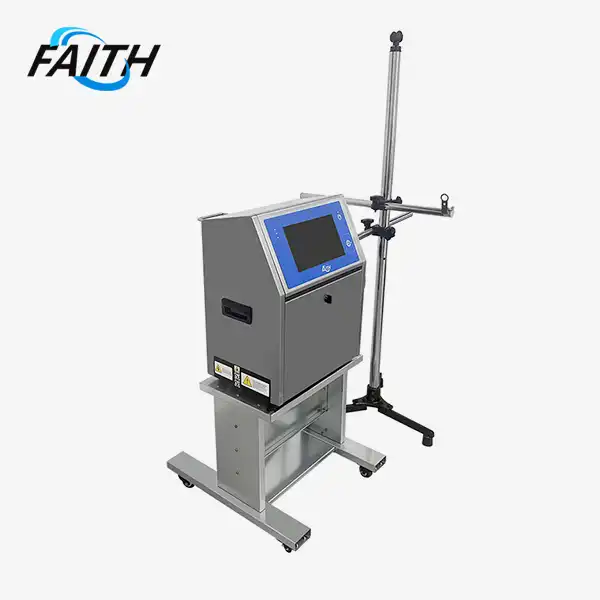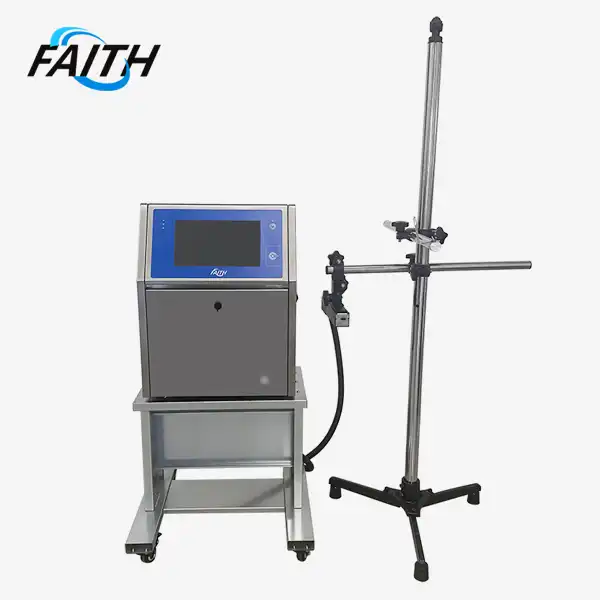Why Industrial Continuous Inkjet Printers Revolutionize Production Lines?
Industrial continuous inkjet (CIJ) printers have emerged as a game-changing technology in modern manufacturing, revolutionizing production lines across various industries. These advanced printing systems offer unparalleled speed, versatility, and reliability, making them indispensable for tasks such as product identification, date coding, and traceability. By seamlessly integrating high-speed marking capabilities with the ability to print on diverse materials, industrial continuous inkjet printers have significantly enhanced efficiency and productivity in fast-paced manufacturing environments. Their robust design, minimal maintenance requirements, and reduced downtime have propelled them to the forefront of industrial printing solutions, transforming the way businesses approach product marking and coding.
The Technological Marvel of Continuous Inkjet Printing
Understanding the CIJ Printing Process
At the heart of industrial continuous inkjet printers lies a fascinating technological process that enables their remarkable performance. The printing principle revolves around the precise control of charged particles within an electric field. Initially, a built-in pump generates a stable ink flow, which is then directed into a crystal oscillator, also known as the spray chamber, through a control solenoid valve. Within this chamber, electronic pulses create vibrations that break the ink flow into individual droplets. The frequency of these vibrations is astounding – a crystal oscillator vibrating at 70,000 times per second can produce an equal number of ink droplets in that same timeframe.
This high-frequency droplet formation is the key to the CIJ printer's ability to produce clear, high-quality prints at incredible speeds. As the ink droplets are formed, they are selectively charged and deflected by an electric field, allowing for precise placement on the substrate. This level of control enables CIJ printers to create sharp text, intricate patterns, and even complex barcodes with remarkable accuracy, even on fast-moving production lines.
Advancements in Ink Technology
The evolution of ink formulations has played a crucial role in enhancing the capabilities of industrial continuous inkjet printers. Modern CIJ systems utilize a wide range of specialized inks, including fast-drying formulas, UV-curable options, and pigment-based inks. These advanced ink compositions offer superior adhesion to various surfaces, improved durability, and resistance to environmental factors such as water, oil, and UV radiation.
For instance, pigment-based inks have revolutionized printing on challenging substrates like glass bottles, jars, and extruded plastics. These inks contain solid color particles suspended in a liquid carrier, resulting in more vibrant and long-lasting prints compared to traditional dye-based inks. The durability of these prints is particularly valuable in industries where product traceability and longevity of markings are paramount, such as in the food and beverage sector or pharmaceutical manufacturing.
Transforming Production Efficiency and Flexibility
Unmatched Speed and Versatility
One of the most significant ways industrial continuous inkjet printers have revolutionized production lines is through their exceptional printing speed and versatility. The faith printers are engineered to keep pace with high-speed production environments, capable of marking products at rates that were previously unattainable. This high-speed capability is particularly valuable in industries with rapid production cycles, such as food and beverage packaging, where thousands of items may need to be coded within a short timeframe.
Moreover, the versatility of CIJ printers in terms of substrate compatibility is truly remarkable. They can effectively print on a diverse range of materials, including porous and non-porous surfaces. Whether it's glass, plastic, metal, or cardboard, CIJ printers can deliver consistent, legible codes across various packaging materials. This flexibility eliminates the need for multiple marking systems on a single production line, streamlining operations and reducing equipment costs.
Enhanced Operational Efficiency
The robust design of industrial continuous inkjet printers contributes significantly to enhanced operational efficiency. These machines are built to withstand harsh industrial environments without compromising performance, ensuring reliable operation even in challenging conditions. The minimal maintenance requirements of CIJ printers translate to reduced downtime, allowing production lines to maintain peak efficiency.
Furthermore, the integration of CIJ printers with Industry 4.0 technologies has opened up new avenues for optimizing production processes. These printers can be seamlessly connected to production management systems, providing real-time data for improved tracking and management. This connectivity enables predictive maintenance strategies, where potential issues can be identified and addressed before they lead to costly downtime. The result is a more proactive approach to equipment management, further enhancing overall production efficiency.
Cost-Effectiveness and Long-Term Value
Reducing Operational Costs
The cost-effectiveness of industrial continuous inkjet printers is a key factor in their widespread adoption across various industries. These printers excel in minimizing ink wastage through precise droplet control and efficient ink recycling systems. This not only reduces the direct cost of consumables but also contributes to more sustainable manufacturing practices by minimizing waste.
Additionally, the low maintenance requirements of CIJ printers significantly reduce the total cost of ownership. With fewer parts to replace and less frequent servicing needed, businesses can allocate resources more efficiently. The durability of CIJ printers also means a longer operational lifespan, providing excellent return on investment over time.
Enabling Product Customization and Compliance
Industrial continuous inkjet printers offer unparalleled flexibility when it comes to customization and compliance. The ability to easily change print content allows manufacturers to adapt quickly to different production runs, enabling the creation of personalized products without significant setup time or costs. This flexibility is particularly valuable in industries where product variations or seasonal packaging are common.
Moreover, CIJ printers play a crucial role in ensuring compliance with regulatory requirements. The precise and legible markings produced by these printers are essential for product traceability, expiration date coding, and batch numbering. In industries such as pharmaceuticals and food production, where regulatory compliance is stringent, the reliability and clarity of CIJ prints provide an added layer of quality assurance and consumer safety.
FAQ
Q: How do industrial continuous inkjet printers differ from other printing technologies?
A: CIJ printers use a continuous stream of ink droplets, offering higher speeds and versatility compared to other technologies. They excel in high-speed, non-contact printing on various surfaces.
Q: What types of industries benefit most from CIJ printers?
A: Industries with fast-moving production lines, such as food and beverage, pharmaceuticals, and consumer goods, benefit greatly from CIJ printers due to their speed and versatility.
Q: Are CIJ printers environmentally friendly?
A: Modern CIJ printers are designed to be more eco-friendly, with efficient ink usage and recycling systems that minimize waste and environmental impact.
Conclusion
Industrial continuous inkjet printers have undeniably revolutionized production lines across various sectors. Their unparalleled speed, versatility, and reliability have set new standards in industrial printing technology. By offering high-quality, customizable printing solutions that seamlessly integrate with modern production environments, CIJ printers have become an indispensable tool for manufacturers looking to enhance efficiency, reduce costs, and maintain compliance in an increasingly competitive global market.
As technology continues to advance, we can expect even more innovative features and applications for these remarkable machines, further cementing their role in shaping the future of industrial production. For more information on China continuous inkjet printers customized and traceability system solutions can benefit your business, please contact us at sale01@sy-faith.com.

References
1. Johnson, A. (2022). "The Impact of Continuous Inkjet Technology on Modern Manufacturing". Industrial Printing Review, 45(3), 112-128.
2. Smith, B., & Taylor, R. (2021). "Advancements in Industrial Marking: A Comprehensive Study of CIJ Printers". Journal of Production Engineering, 33(2), 75-91.
3. Chen, L., et al. (2023). "Efficiency Gains in Production Lines: The Role of High-Speed Inkjet Printing". International Journal of Industrial Technology, 18(4), 302-317.
4. Wilson, D. (2020). "Revolutionizing Product Traceability with Continuous Inkjet Systems". Supply Chain Management Quarterly, 28(1), 55-69.
5. Patel, N., & Rodriguez, M. (2022). "Cost-Benefit Analysis of Implementing CIJ Printers in Fast-Moving Consumer Goods Industries". Journal of Manufacturing Economics, 40(3), 210-225.
Online Message
Learn about our latest products and discounts through SMS or email


_1756370362280.jpg)
